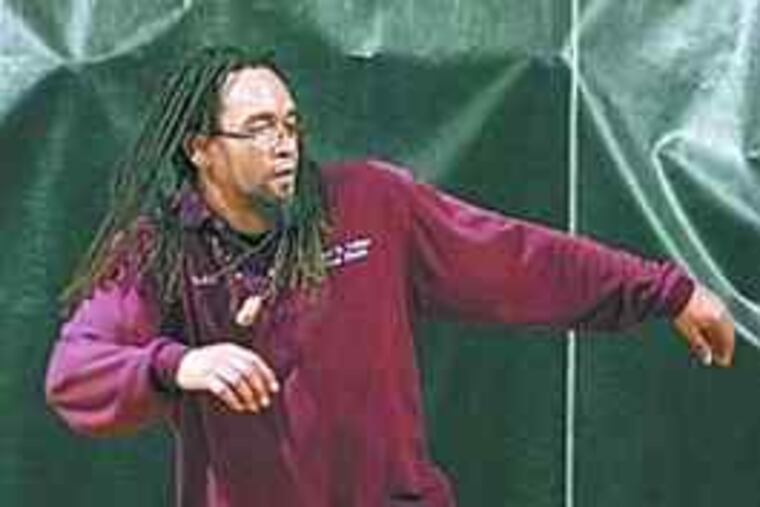Secrets of Black Philadelphia: South Philly
It's only once in a blue moon that a new name surfaces from Philadelphia's Civil War-era black history. Last Wednesday it happened with the public debut of the diaries of Emilie Davis, housed at the Historical Society of Pennsylvania.

Person
Introducing Emilie Davis
It's only once in a blue moon that a new name surfaces from Philadelphia's Civil War-era black history. Last Wednesday it happened with the public debut of the diaries of Emilie Davis, housed at the Historical Society of Pennsylvania.
Davis, who lived at 916 Rodman St., was an ordinary, everyday free black woman of her times. (Sadly, no likeness of her is known to exist.)
Mostly she writes about shopping, going to church, and visiting with friends and suitors. "She's shopping and she's dealing with her hair and with boys — and there's a war going on," historian K. Wise Whitehead, a researcher who's been studying the diaries, said, laughing.
But her very ordinariness makes Davis very special, since historians can count on one hand the number of ordinary free blacks from her era whose memoirs have survived until now, Whitehead said.
"She fills the void between the elite and the enslaved."
The passages in Davis' leather-bound diaries span three momentous years of American history, starting on Jan. 1, 1863, the day of the Emancipation Proclamation (she celebrated at a party that night) and ending on Dec. 31, 1865.
There's a separate diary for each year.
Davis occasionally has a brush with history, hearing black abolitionist Frederick Douglass speak and watching President Lincoln's funeral procession pass through town.
Her brother goes off to fight the Civil War, then comes home and dies of a battle wound.
The diaries themselves aren't on view. But big color photographs of them and some passages concerning Lincoln's assassination are featured in a Lincoln exhibit that runs now through May 1 at the historical society. Whitehead is writing a book, so stay tuned for more.
Christian Street YMCA
Four members of the Basketball Hall of Fame played hoops here as kids: Charles "Tarzan" Cooper, Earl "the Pearl" Monroe, John Chaney and Wilt Chamberlain (the 6-foot-10-inch 10th-grader in the back row of the photo below).
Thousands of black children learned how to swim from legendary youth directors like Frank "Tick" Coleman and Buddy Burbage.
For decades, black superstars who came through town regularly stopped in to visit, including champion boxer Joe Louis and Olympic gold-medal runner Wilma Rudolph.
And that's just the celebrity side of what makes the Christian Street YMCA noteworthy.
On the historicside, the Christian Street Y, which opened in 1914, was the second black YMCA in America and the first to have its own building. It was the only indoor pool in Philly where blacks were allowed to swim before the mid-1950s.
In its heyday, the Y was chiefly known as a citywide basketball mecca. "Whoever played any kind of basketball came through the doors," said executive director Michele Stevenson. Chamberlain played for the 1953 Christian Street team that won the YMCA national championship.
The original building was replaced in 1974. But the new facility, at 1724 Christian St., has remarkable black-and-white photographs on display that date as far back as the 1920s.
The Philly shim sham
In the 1930s and '40s, South Street was the center of the jazz tap universe, with marquee performers like the Nicholas Brothers and LaVaughn Robinson banging out rhythms on street corners for tips and props.
They were known for a distinct Philadelphia hoofing style, fast and close to the ground, and for two signature moves: the Philly shim sham and the paddle and roll.
The Philadelphia style was epitomized by Robinson, who progressed from South Street's corners to the pinnacle of the dance world, honored by the National Endowment for the Arts as a "national treasure." Robinson died last year, and adoring students who learned the steps at his feet — literally — are now passing them along to the next generation.
Robinson used to teach that the rhythm of the paddle and roll should sound like one-potato-two-potato, said protege Robert Burden, and that's how Burden teaches it today in college dance classes at the University of the Arts and grade-school assemblies throughout the region.
Then he instructs students to pass along its history when they pass along the rhythm. "You say, 'I got it from Robert Burden, who got it from LaVaughn Robinson, from Philadelphia,'" he said.
Burden's educational dance troupe, Tap Team Two, performs mainly for school groups (call 215-868-8456 for bookings), but on March 14 it is doing a public show at the Community Education Center in University City. It'll finish with the Philly shim sham.
"That's like the national anthem to tap dancers," Burden said. "The last dance that we do is always a tribute to LaVaughn."
If you have other plans for the March 14, go online to http://go.philly.com/shimsham where Burden demonstrates the steps that put Philadelphia on the tap map.*